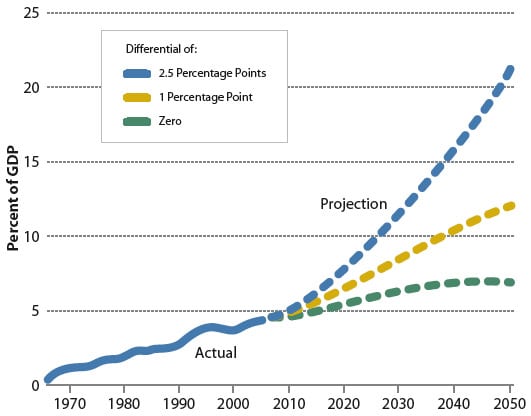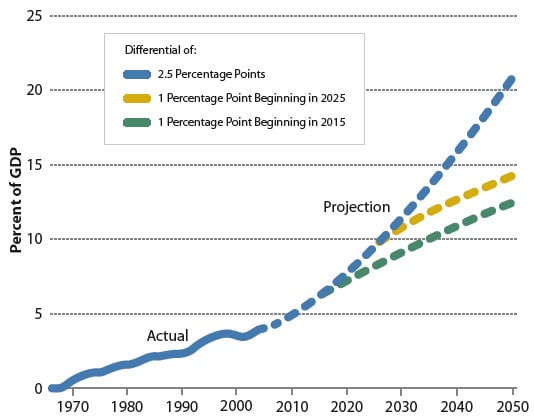California is the world’s eighth largest economy and generates 13% of U.S. wealth. Yet Governor Arnold Schwarzenegger says high temperatures, low rainfall, and a growing population have created a water crisis there. A third of the state is in extreme drought and, if there’s another dry season, faces catastrophe. The governor fears that his economy could collapse without a $5.9 billion program to build more dams.
His concerns are widely shared in the United States—not to mention in dry Australia, Spain, China, and India. Yet as California desperately seeks new dam construction, it simultaneously leads the world in old dam destruction. It razes old dams for the same reasons it raises new dams: economic security, public safety, water storage efficiency, flood management, job creation, recreation, and adaptation to climate change. Dam-removal supporters include water districts, golf courses, energy suppliers, thirsty cities, engineers, farmers, and property owners.
With 1,253 dams risky enough to be regulated and 50 times that many unregistered small dams, California is a microcosm of the world. There are more than 2.5 million dams in the United States, 79,000 so large they require government monitoring. There are an estimated 800,000 substantial dams worldwide. But within the next two decades, 85% of U.S. dams will have outlived their average 50-year lifespan, putting lives, property, the environment, and the climate at risk unless they are repaired and upgraded.
Neither dam repair nor dam removal is a recent phenomenon. What is new is their scale and complexity as well as the number of zeros on the price tag. Between 1920 and 1956, in the Klamath River drainage 22 dams were dismantled at a total cost of $3,000. Today, the removal of four dams on that same river—for jobs, security, efficiency, safety, legal compliance, and growth—will cost upwards of $200 million.
Which old uneconomical dams should be improved or removed? Who pays the bill? The answers have usually come through politics. Pro-dam and anti-dam interests raise millions of dollars and press their representatives to set aside hundreds of millions more tax dollars to selectively subsidize pet dam projects. Other bills bail out private owners: A current House bill earmarks $40 million for repairs; another one sets aside $12 million for removals. The outcome is gridlock, lawsuits, debt spending, bloated infrastructure, rising risks, dying fisheries, and sick streams.
Dam decisions don’t have to work that way. Rather than trust well-intentioned legislators, understaffed state agencies, harried bureaucrats, or nonscientific federal judges to decide the fate of millions of unique river structures, there’s another approach. State and federal governments should firmly set in place safety and conservation standards, allow owners to make links between the costs and benefits of existing dams, and then let market transactions bring health, equity, and efficiency to U.S. watersheds. Social welfare, economic diversity, and ecological capital would all improve through a cap-and-trade system for water infrastructure. This system would allow mitigation and offsets from the vast stockpile of existing dams while improving the quality of, or doing away with the need for, new dam construction.
Big benefits, then bigger costs
A new dam rises when its public bondholder/taxpayer or private investor believes that its eventual benefits will outweigh immediate costs. When first built, dams usually fulfill those hopes, even if the types of benefits change over time. In early U.S. history, hundreds of dams turned water mills or allowed barge transport. Soon, thousands absorbed flood surges, diverted water for irrigation, or slaked the thirst of livestock. Later still, tens of thousands generated electrical power, stored drinking water for cities, and provided recreation. North America built 13% of its largest dams for flood control, 11% for irrigation, 10% for water supply, 11% for hydropower, 24% for some other single purpose such as recreation or navigation, and 30% for a mix of these purposes. Today, the primary reason is drinking water storage and, to a far lesser extent, hydropower and irrigation.
Unfortunately, we usually fail to heed all the indirect, delayed, and unexpected downstream costs of dams. With planners focused primarily on near-term benefits, during the past century three large dams, on average, were built in the world every day. Few independent analyses tallied exactly why those dams came about, how they performed, and whether people have been getting a fair return on their $2 trillion investment. Now that the lifecycle cost is becoming manifest, we are beginning to see previously hidden costs.
First, it turns out that a river is far more than a natural aqueduct. It is a dynamic continuum, a vibrant lifeline, a force of energy. Dams, by definition, abruptly stop it. But all dams fill with much more than water. They trap river silt or sediment at rates of between 0.5% and 1% of the dam’s storage capacity every year. Layer by layer, that sediment settles in permanently. By restraining sediment upstream, dams accelerate erosion below; hydrologists explain that dams starve a hungry current that then must scour and devour more soil from the river bed and banks downstream. Silt may be a relatively minor problem at high altitudes, but it plagues U.S. landscapes east of the Rockies, where precious topsoil is crumbling into rivers, backing up behind dams, and flowing out to sea. Removing trapped sediment can cost $3 per cubic meter or more, when it can be done at all.
NEITHER DAM REPAIR NOR DAM REMOVAL IS A RECENT PHENOMENON. WHAT IS NEW IS THEIR SCALE AND COMPLEXITY AS WELL AS THE NUMBER OF ZEROS ON THE PRICE TAG.
The second enemy is the sun. Whereas sediment devours reservoir storage from below, radiant heat hammers shallows from above. In dry seasons and depending on size, dam reservoirs and diversions can evaporate more water than they store. Rates vary from dam to dam and year to year, but on average evaporation annually consumes between 5% and 15% of Earth’s stored freshwater supplies. That’s faster than many cities can consume. It’s one of the reasons why the Rio Grande and Colorado Rivers no longer reach the sea and why precious alluvial groundwater is shrinking, too. Nine freshwater raindrops out of 10 fall into the ocean, so the trick is to see the entire watershed—from headwater forest to alluvial aquifers through downstream floodplain—as potentially efficient storage and tap into water locked beneath the surface. Today, irrigators pump more groundwater than surface water. In arid landscapes, water is more efficiently and securely stored in cool, clean alluvial aquifers than in hot, shallow, polluted reservoirs.
The third threat to dam performance, as both a cause and a consequence, is climate change. Dams are point-source polluters. Scientists have long warned that dams alter the chemistry and biology of rivers. They warm the water and lower its oxygen content, boosting invasive species and algae blooms while blocking and killing native aquatic life upstream and down. Rivers host more endangered species than any other ecosystem in the United States, and many of the nation’s native plants and animals, from charismatic Pacific salmon to lowly Southern freshwater mussels, face extinction almost entirely because of dams.
What we didn’t appreciate until recently is that dams also pollute the air. The public may commonly see dams as producers of clean energy in a time of dirty coal and escalating oil prices. Yet fewer than 2% of U.S. dams generate any power whatsoever. Some could be retrofitted with turbines, and perhaps various existing dams should be. But peer-reviewed scientific research has demonstrated that dams in fact may worsen climate change because of reservoir and gate releases of methane. Brazil’s National Institute for Space Research calculated that the world’s 52,000 large dams (typically 50 feet or higher) contribute more than 4% of the total warming impact of human activities. These dam reservoirs contribute 25% of human-caused methane emissions, the world’s largest single source. Earth’s millions of smaller dams compound that effect.
Worse, as climate change accelerates, U.S. dams will struggle to brace for predicted drought and deluge cycles on a scale undreamed of when the structures were built. This brings us to the fourth danger. Dams initially designed for flood control may actually make floods more destructive. First, they lure people to live with a false sense of security, yet closer to danger, in downstream floodplains. Then they reduce the capacity of upstream watersheds to absorb and control the sudden impact of extreme storms. Looking only at mild rainstorms in October 2005 and May 2006, three states reported 408 overtoppings, breaches, and damaged dams. Only half of the nation’s high-hazard dams even have emergency action plans.
The scariest aspect of dams’ liabilities is the seemingly willful ignorance in the United States of their long-term public safety risks. Engineers put a premium on safety, from design to construction through eventual commission. Yet after politicians cut the ceremonial ribbon, neglect creeps in. As dams age they exhibit cracks, rot, leaks, and in the worst cases, failure. In 2006, the Kaloko Dam on the Hawaiian island of Kauai collapsed, unleashing a 70-foot-high, 1.6-million-ton freshwater tsunami that carried trees, cars, houses, and people out to sea, drowning seven. This is not an isolated exception, but a harbinger.
These preventable tragedies happen because both public and private dams lack funds for upkeep and repair. In 2005, the American Society of Civil Engineers gave U.S. dams and water infrastructure a grade of D and estimated that nationwide, repairing nonfederal dams that threaten human life would cost $10.1 billion. The U.S. Association of State Dam Safety Officials (ASDSO) placed the cost of repairing all nonfederal dams at $36.2 billion. Yet Congress has failed to pass legislation authorizing even $25 million a year for five years to address these problems.
Cash-strapped states generally don’t even permit dam safety officials to perform their jobs adequately. Dozens of states have just one full-time employee per 500 to 1,200 dams. Hence state inspectors, like their dams, are set up to fail. Between 1872 and 2006, the ASDSO reports, dam failures killed 5,128 people.
As environmental, health, and safety regulations drive up the cost of compliance, owners of old dams tend to litigate or lobby against the rules. Others simply walk away. The number of abandoned or obsolete dams keeps rising: 11% of inventoried dams in the United States are classified under indeterminate ownership.
To date, warnings have been tepid, fitful, disregarded, or politicized. In 1997, the American Society of Civil Engineers produced good guidelines for the refurbishment or retirement of dams. They have been ignored. In 2000, the landmark World Commission on Dams established criteria and guidelines to address building, managing, and removing dams, but its report so challenged water bureaucrats that the World Bank, the commission’s benefactor, has tried to walk away from its own creation. Environmental organizations have published tool kits for improving or removing old dams, but activists often target only the most egregious or high-profile dozen or so problems that best advance their profile or fundraising needs.
Dams have always been politically charged and often the epitome of pork-barrel projects. For the same reasons, dam removal can get bipartisan support from leading Democrats and Republicans alike. The switch from the Clinton to Bush administrations led to attempted alterations of many natural resource policies, but one thing did not change: the accelerating rate of dam removals. In 1998, a dozen dams were terminated; in 2005, some 56 dams came down in 11 states. Yet despite bipartisan support, there has never been any specific dam policy in either administration. A dam’s demise just happened, willy-nilly, here and there. Dams died with less legal, regulatory, or policy rationale than accompanied their birth.
Thoreau had it right
No laws, no regulations, no policy? Federal restraint remains an alluring ideal in a nation that feels cluttered with restrictions. It’s a deeply ingrained American sentiment, embodied in Henry David Thoreau’s famous remark in Civil Disobedience: “That government is best which governs least.” Yet the founder of principled civil disobedience was also the first critic of seemingly benign dams because of their unintended effects.
While paddling with his brother on the Concord and Merrimack Rivers in 1839, Thoreau lamented the disappearance of formerly abundant salmon, shad, and alewives. Vanished. Why? Because “the dam, and afterward the canal at Billerica …put an end to their migrations hitherward.” His elegy reads like an Earth First! manifesto: “Poor shad! where is thy redress? …armed only with innocence and a just cause …I for one am with thee, and who knows what may avail a crowbar against that Billerica dam?”
Thoreau restrained himself from vigilante dam-busting, but 168 years later the effects of the country’s dams have only multiplied in number and size. Happily, the end of Thoreau’s tale might nudge us in the right direction. He did not complain to Washington or Boston for results, funds, or a regulatory crackdown. He looked upstream and down throughout the watershed and sought to build local consensus. Because the dam had not only killed the fishery but buried precious agricultural farmland and pasture, Thoreau advocated an emphatically civic-minded, consensus-based, collective, economically sensible proposal, in which “at length it would seem that the interests, not of the fishes only, but of the men of Wayland, of Sudbury, of Concord, demand the leveling of that dam.”
In other words, if those watershed interests were combined, they could sort out fixed liabilities from liquid assets. The economic beneficiaries of a flowing river, including the legally liable dam owner, should pay the costs of old dam removal, just as the beneficiaries of any new dam pay the costs of its economic, environmental, and security effects. In a few words, Thoreau sketched the outlines of what could emerge as a policy framework for existing dams that could be adapted to a river basin, a state, or a nation.
The most successful and least intrusive policies can be grouped under the strategic approach known as cap and trade. That is, the government sets a mandatory ceiling on effects, pollution, or emissions by a finite group of public and private property stakeholders. This ceiling is typically lower than present conditions. But rather than forcing individual stakeholders to comply with that target by regulatory fiat, each one can trade offsets, what amount to pollution credits, with each other. Those who cut waste, emissions, and effects better may sell their extra credits to laggards or newcomers. This approach leverages incentives to reform, innovate, and improve into a competitive advantage in which everyone benefits, and so does nature. Although it did not involve dams, a cap-and-trade policy was tested nationally under the 1990 Clean Air Act revisions aimed at cutting acid rain–causing sulfur dioxide emissions of U.S. factories in half. When it was announced, the utility industry gloomily predicted a clean-air recession, whereas environmentalists cried sellout over the lack of top-down regulatory controls. But cap and trade turned out to reduce emissions faster than the most optimistic projection. The industry grew strong and efficient, and the result was the largest human health gains of any federal policy in the 1990s. Annual benefits exceeded costs by 40:1.
Since then, cap-and-trade policies have proliferated from India to China to Europe. Though far from flawless, a cap-and-trade carbon policy is one success story to emerge from the troubled Kyoto Protocol to reduce emissions that accelerate climate change. Nations and multinational corporations such as General Electric and British Petroleum used it to reduce polluting emissions of carbon dioxide and methane while saving voters and shareholders money in the process. More recently, atmospheric cap and trade has been brought down to earth; the valuation and exchange in environmental offsets have been applied to land and water ecosystems. Certain states use cap and trade in policies to curb nitrogen oxides and nonpoint water pollution, others to reduce sediment loads and water temperature, and still others to trade in water rights when diversions are capped. California’s Habitat Conservation Plans work within the Endangered Species Act’s “cap” of preservation, yet allow “trade” of improving, restoring, and connecting habitat so that although individuals may die, the overall population recovers. Under the Clean Water Act, a cap-and-trade policy encourages mitigation banking and trading, which leads to a net gain in wetlands.
In each case the policy works because it lets democratic governments do what they do best—set and enforce a strict uniform rule—while letting property owners, managers, investors, and entrepreneurs do what they do best: find the most cost-effective ways to meet that standard. Given the documented risks of the vast stockpile of aging dam infrastructure in the United States, a cap-and-trade policy for dams could be tested to see if it can restore efficiency, health, and safety to the nation’s waters.
Making the policy work
The first step would be to inventory and define all the stakeholders. In air-quality cap-and-trade cases, these include factory owners, public utilities, manufacturers, refineries, and perhaps even registered car owners. In the case of dams, one could begin with the 79,000 registered owners in the National Inventory of Dams. Tracking down ownership of the estimated 2.5 million smaller unregistered dams may prove a bit challenging, until their owners realize that dismantling the dams can yield profit if removal credits can be bought and sold.
The second step would be to recognize the legitimate potential for trades. Dams yield (or once yielded) economic benefits, but every dam also has negative effects on air emissions and water quality, quantity, and temperature, therefore on human health and safety, economic growth, and stability. Even the most ardent dam supporter acknowledges that there is room for potentially significant gains in performance from dams as well as from the rivers in which they squat. Whereas the top-down goal in the past had been to subsidize or regulate new dams for their economic benefits, the aim in this case is horizontal: to encourage an exchange to reduce old dams’ economic and ecological costs.
Third, quantify the kind, extent, and nature of those negative effects. Our scientific tools have advanced considerably and are now ready to measure most if not all of those qualitative damages observed by amateurs since Thoreau. By breaking them down into formal “conservation units,” degrees Celsius, water quality, cubic meters of sediment, and so forth, we can quantify potential offsets in ecological and economic terms. The United States could set out rigorous scientific standards modeled on the Clean Air Act cap-and-trade policy or wetlands mitigation banking,
Fourth, start small, then replicate and scale up with what works best. The pilot exchanges could be structured by geography or by type of effect. But both kinds of pilot programs have already begun. One creative company in North Carolina, Restoration Systems, has begun to remove obsolete dams to gain wetlands mitigation credits that it can sell and trade, in most cases, to offset the destruction of nearby wetlands by highway building. In Maine, several dams in the Penobscot River watershed have been linked through mitigation as part of a relicensing settlement. On the Kennebec River, also in Maine, the destruction cost of the Edwards Dam was financed in large part by upstream industrial interests and more viable dams as part of a package for environmental compliance. On the west coast, the Bonneville Power Administration is using hydropower funds to pay for dam removals on tributaries within the Columbia River basin.
These early efforts are fine, but restricted geographically; each approach could be allowed to expand. The larger the pool of stakeholders, the greater are the economies of scale and the more efficient the result. But a national consensus and standards do not emerge overnight, nor should they, given that there are so many different dams. Each dam is unique in its history and specific in its effects, even though the cumulative extent and degree of those effects are statewide, national, and sometimes even global. A cap-and-trade policy will emerge nationally only as it builds on examples like these.
Finally, work within existing caps while using a standard that lets the amoral collective marketplace sort out good from bad. The beauty of this framework is that many of the national standards are already in place. Legal obligations to comply with the National Environmental Policy Act, Endangered Species Act, Clean Water Act, and Clean Air Act all have strong bearing on decisions to remove or improve dams. Some tweaking may be required, but perhaps not much. Recently, Congress revised the Magnuson-Stevens Act to pilot cap-and-trade policies in fishery management, in which fishermen trade shares of a total allowable or capped offshore catch of, say, halibut or red snapper.
Those overworked state and federal agencies responsible for enforcing laws—the ASDSO, the Army Corps of Engineers, the Fish and Wildlife Service, the National Marine Fisheries Services, and the Environmental Protection Agency— need not get bogged down in the thankless task of ensuring that each and every dam complies with each and every one of the laws. Dam owners may have better things to do than argue losing battles on several fronts with various government branches. All parties can better invest their time according to their mandate, strengths, and know-how: officials in setting the various standard legal caps and ensuring that they are strictly applied to the entire tributary, watershed, state, or nation; and dam owners in trading their way to the best overall result.
A cap-and-trade scenario
Suppose, for example, that a worried governor determines to cap at one-third below current levels all state dam effects: methane emissions, sedimentation rates, evaporative losses, aquatic species declines, habitat fragmentations, artificial warming, reduced oxygen content, and number of downstream safety hazards. He wants these reductions to happen within seven years and is rigorous in enforcing the ceiling. That’s the stick, but here’s the carrot: He would allow dam owners to decide how to get under that ceiling on their own.
At first, dam owners and operators, public as well as private, could reliably be expected to howl. They would label the policy environmentally extreme and say it was sacrificing water storage, energy, food, and flood control. But eventually, innovative dam owners and operators would see the policy for what it really is: a flexible and long-overdue opportunity with built-in incentives to become efficient and even to realize higher returns on existing idle capital. They would seize a chance to transform those fixed liabilities into liquid assets.
One likely effect would be private acquisition of some of the many thousands of small orphan dams. By liquidating these, an investor would accumulate a pool of offset credits that could be sold or traded to cumbersome dams with high value but low flexibility. This development has already emerged in isolated cases. In northern Wisconsin, the regional power company bought and removed two small, weak dams in exchange for a 25-year license to operate three healthier ones in the same watershed. Utilities in the West have taken notice and begun to package their relicensing strategies accordingly.
Another predictable outcome would be that, in order to retain wide popular and political support, big power, transport, and irrigation dam projects—think Shasta, Oroville, San Luis Reservoir, Glen Canyon, and Hoover—would mitigate their effects first by looking upstream at land and water users, then at other smaller dams that could be upgraded, retrofitted, or removed to gain efficiencies in ways easier or cheaper than they could get by overhauling their own operations and managements.
There would also be a likely expansion outward and upward in user fees raised from formerly invisible or subsidized beneficiaries from the services of existing dams. Such services range from recreational boaters, anglers, and bird hunters to urban consumers, lakefront property owners, and even those who merely enjoy the bucolic view of a farm dam. These disaggregated interests have largely supported dams, but only as long as others foot the bill for maintenance and upkeep. Economists call them free riders, and a new cap-and-trade dam policy would reduce their ranks. Dams that failed to generate enough revenues to meet national standards could earn credits by selling themselves to those interests that could. This happened when viable upstream industries on the Kennebec River helped finance the removal of Edwards Dam.
Another effect would be an innovation revolution in the kinds of tools and technologies that are already in the works but that have lacked a national incentive to really flourish. These include new kinds of fish passages, dredging techniques, low-flush toilets, and timed-drip irrigation, along with a more aggressive use of groundwater that pumps reservoir water underground as soon as it is trapped. The range of tools would also include financial instruments; in the West, they might accelerate the trading in water rights between agricultural, industrial, urban, and environmental users that has begun in Oregon, Montana, Washington, and California.
This brings us to a final advantage of a cap-and-trade policy for existing dams: global competitiveness. Seventy years ago, the United States set off a macho global race to build the biggest dams on Earth, starting with Hoover. It’s not clear which country won the top-down competition, which displaced 80 million people and amputated most of Earth’s rivers. But a new horizontal policy can lead to a competitive advantage. Whether scaled to tributaries or based on federal standards, the United States gains through dam consolidation, efficiencies, and innovation. Flexibility and incentives in a coast-to-coast market lower the transaction costs of repair or removal. Economies of scale would spur a substantial new dam removal and mitigation industry akin to the clean-air industry of scrubbers, software, and innovative technology sparked by the Clean Air Act or the Kyoto Protocol cap-and-trade policy. These don’t just bring down the costs of such policies in the United States; they create conditions for a competitive advantage for the United States. Exporting technology and skills will be in high demand beyond our borders, especially in China, Russia, and India, where most dams lie and where sedimentation and evaporation rates are high and dam safety and construction standards are low.
What is keeping this policy from emerging? Mostly it is because the competing governmental and nongovernmental organizations engaged in water think of dams as solitary entities locked within sectoral and jurisdictional cubicles. They fail to recognize that all dams have a national impact, positive and negative, on the life and livelihoods of communities throughout the United States.
A RIVER IS A DYNAMIC CONTINUUM, A VIBRANT LIFELINE, A FORCE OF ENERGY.
We regard as distinct each dam operated by the U.S. Bureau of Reclamation, Army Corps of Engineers, Tennessee Valley Authority, or Bonneville Power Administration. Together those public projects total half of the nation’s hydropower generation, but each is often seen as outside the laws that govern private hydropower authorized under the Federal Power Act. In turn, the 2,000 hydro dams overseen by the Federal Energy Regulatory Commission fall into one category and the 77,000 nonhydro (but federally registered) dams into another. We see 39,000 public dams as different from 40,000 private dams. We regulate irrigation dams differently from navigation dams and assign water rights to dams in western states but apply common law in eastern states, even when dams share the same river. Two dams on the same stream owned by the same company are subject to different environmental laws. We put 2.5 million small dams in a different category from 79,000 larger dams. The predictable mess is arbitrary and absurd and cries out for an overarching national policy.
Taking note of seemingly contradictory trends around dam construction and destruction worldwide, one might ask, “How far will the current trends go? How many old dams are we talking about repairing or removing? Hundreds? Thousands? A few big ones? A million little ones? Do we need more dams or fewer?”
Such questions largely miss the point of the policy envisioned here. We don’t need a specific number of dams, but rather we need healthier rivers, safer societies, and a more efficient and disciplined water-development infrastructure. How we get there is beyond the capacity of a single person to decide; only through a flexible horizontal market can we answer, together. A government policy can be the catalyst for and guide the direction of this market because it removes personal, political, ideological, and geographic biases from the equation. Nothing environmental and safety activists say or do can prevent new dam construction, and nothing dam supporters say or do can prevent old dams from coming down. But if the nation’s anti-dam and pro-dam interests were gathered collectively under the same fixed national ceiling and left to their own devices, Adam Smith’s “human propensity to truck, barter and exchange” could unite with the spirit of Thoreau’s civil “wildness.” A cap-and-trade dam policy’s embedded incentives would encourage the market’s invisible hand while ensuring its green thumb.
The United States once led the world in the construction of dams, but over time, many have deteriorated. Now, under a cap-and-trade policy, it can bring horizontal discipline to that vertical stockpile of fixed liabilities, reducing risks while improving the health and safety of living communities. The United States can once again show the way forward on river development. Through such a cap-and-trade policy it can help dams smoothly and efficiently evolve with the river economies to which they belong.
Let us close where we began, with Governor Schwarzenegger. If states are indeed the laboratories of U.S. democracy, he stands in a unique position to mount a market-based experiment for the United States as part of his agenda to build bigger, higher, and more new dams for water storage. He has already expanded in-state cap-and-trade schemes in water transfers, endangered species habitats, ocean fishery rights, and carbon emissions. He is open to the idea of removing the O’Shaughnessy Dam that has submerged Hetch Hetchy Valley in Yosemite National Park, even while he seeks more water storage elsewhere. Now, as the governor makes his pitch for big new multibillion dollar dams to save California from parched oblivion, he and other governors, not to mention heads of state from Beijing to Madrid to New Delhi to Washington, DC, could institute effective new policies to protect Earth’s liquid assets.








 Einstein’s scientific genius actually made it hard for us to learn his political views. Intimidated by his brilliant insights into things beyond our ken, we hesitated to seek his political counsel. And Einstein knew his own limitations, admitting in 1930 that,“My passionate interest in social justice and social responsibility has always stood in curious contrast to a marked lack of desire for direct association with men and women.”
Einstein’s scientific genius actually made it hard for us to learn his political views. Intimidated by his brilliant insights into things beyond our ken, we hesitated to seek his political counsel. And Einstein knew his own limitations, admitting in 1930 that,“My passionate interest in social justice and social responsibility has always stood in curious contrast to a marked lack of desire for direct association with men and women.”